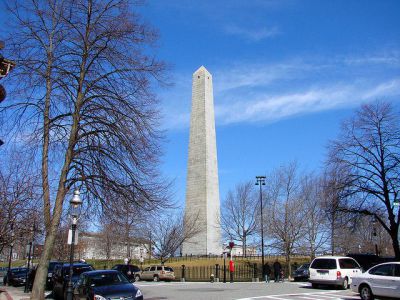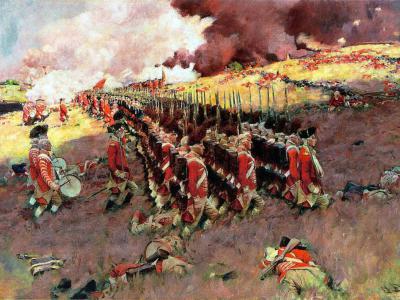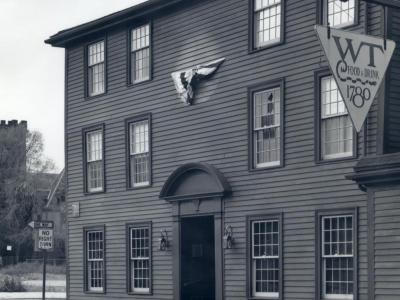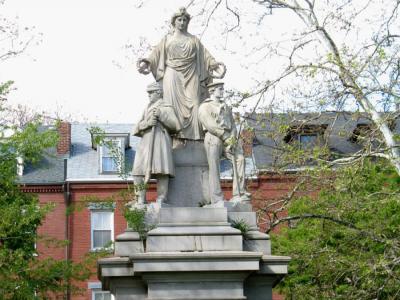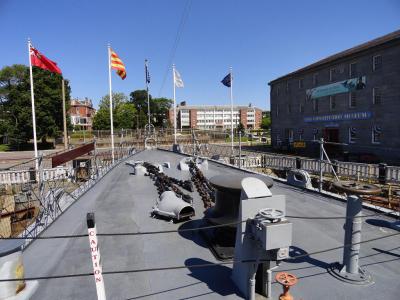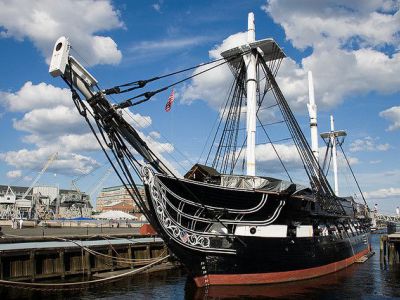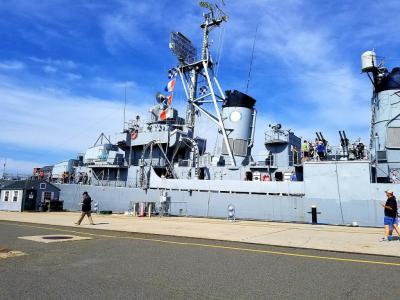Bunker Hill Walking Tour (Self Guided), Boston
Bunker Hill, sitting on the bank of the Charles River in Boston, Massachusetts, is a historic site that holds great significance in American history. At its heart stands the Bunker Hill Monument, a towering obelisk commemorating the Battle of Bunker Hill, a pivotal event in the American Revolutionary War.
The battle took place on June 17, 1775, when American patriots faced off against British forces. Despite being outnumbered, the colonists fought fiercely, employing the famous tactic of "Don't Fire Until You See the Whites of Their Eyes." While the British won the battle, they suffered heavy losses. This “Pyrrhic Victory” weakened their resolve and boosted American morale, galvanizing support for the revolutionary cause. It ultimately set the stage for the formal Declaration of Independence in 1776.
The adjacent park area features a cool statue of William Prescott, leader of the rebels, and the lovely Bunker Hill Museum, which provides visitors with a deeper understanding of the battle and the broader American Revolution. Inside, you can see a diorama presentation plus other exhibits, artifacts, and interactive displays.
A relatively short walk from the museum is the Warren Tavern, a historic pub that dates back to 1780. It's a charming spot where you can enjoy a meal and/or grab a pint while soaking in the ambiance of the past. The tavern was a favorite gathering place for Revolutionary War figures like Paul Revere and George Washington.
Venturing further, you'll find the Civil War Memorial, which pays tribute to those who fought and perished during the Civil War – a poignant reminder of another critical period in American history.
If you're interested in all things naval, head to the next big sight: the Boston Navy Yard, home to the USS Constitution, the famous Revolutionary War-era frigate known as “Old Ironsides.” This vessel played a vital role in the War of 1812 and remains a symbol of American naval prowess. Nearby, the USS Cassin Young, a World War II destroyer, offers further insights into America's maritime heritage.
Exploring Bunker Hill and its surroundings offers a captivating journey through America's past. Follow this self-guided tour and you will find it a great addition to the long list of Boston’s historical must-sees.
The battle took place on June 17, 1775, when American patriots faced off against British forces. Despite being outnumbered, the colonists fought fiercely, employing the famous tactic of "Don't Fire Until You See the Whites of Their Eyes." While the British won the battle, they suffered heavy losses. This “Pyrrhic Victory” weakened their resolve and boosted American morale, galvanizing support for the revolutionary cause. It ultimately set the stage for the formal Declaration of Independence in 1776.
The adjacent park area features a cool statue of William Prescott, leader of the rebels, and the lovely Bunker Hill Museum, which provides visitors with a deeper understanding of the battle and the broader American Revolution. Inside, you can see a diorama presentation plus other exhibits, artifacts, and interactive displays.
A relatively short walk from the museum is the Warren Tavern, a historic pub that dates back to 1780. It's a charming spot where you can enjoy a meal and/or grab a pint while soaking in the ambiance of the past. The tavern was a favorite gathering place for Revolutionary War figures like Paul Revere and George Washington.
Venturing further, you'll find the Civil War Memorial, which pays tribute to those who fought and perished during the Civil War – a poignant reminder of another critical period in American history.
If you're interested in all things naval, head to the next big sight: the Boston Navy Yard, home to the USS Constitution, the famous Revolutionary War-era frigate known as “Old Ironsides.” This vessel played a vital role in the War of 1812 and remains a symbol of American naval prowess. Nearby, the USS Cassin Young, a World War II destroyer, offers further insights into America's maritime heritage.
Exploring Bunker Hill and its surroundings offers a captivating journey through America's past. Follow this self-guided tour and you will find it a great addition to the long list of Boston’s historical must-sees.
How it works: Download the app "GPSmyCity: Walks in 1K+ Cities" from Apple App Store or Google Play Store to your mobile phone or tablet. The app turns your mobile device into a personal tour guide and its built-in GPS navigation functions guide you from one tour stop to next. The app works offline, so no data plan is needed when traveling abroad.
Bunker Hill Walking Tour Map
Guide Name: Bunker Hill Walking Tour
Guide Location: USA » Boston (See other walking tours in Boston)
Guide Type: Self-guided Walking Tour (Sightseeing)
# of Attractions: 7
Tour Duration: 1 Hour(s)
Travel Distance: 1.5 Km or 0.9 Miles
Author: anna
Sight(s) Featured in This Guide:
Guide Location: USA » Boston (See other walking tours in Boston)
Guide Type: Self-guided Walking Tour (Sightseeing)
# of Attractions: 7
Tour Duration: 1 Hour(s)
Travel Distance: 1.5 Km or 0.9 Miles
Author: anna
Sight(s) Featured in This Guide:
- Bunker Hill Monument
- Bunker Hill Museum
- Warren Tavern
- Civil War Memorial
- Boston Navy Yard
- USS 'Constitution'
- USS 'Cassin Young'
1) Bunker Hill Monument
This monument stands as a tribute to the Battle of Bunker Hill, a pivotal clash fought on June 17, 1775, during the Siege of Boston at the outset of the American Revolutionary War. The 221-foot granite obelisk took shape between 1827 and 1843, using granite sourced from Quincy, Massachusetts, and transported to the site by way of the specially constructed Granite Railway, followed by a barge journey.
It all started with the British attempts to fortify the unoccupied hills surrounding Boston in a bid to gain control over the city harbor. In response, American colonial troops stealthily occupied Bunker and Breed's hills, fortifying them as defensive line. Once the British become aware of this, they launched waves of attacks against the colonial forces and incurred substantial casualties. The battle ended only after the defenders ran out of ammunition and proved somewhat Pyrrhic a victory for the British. Although tactically they won, the battle had clearly demonstrated that inexperienced American militia were could stand their ground against the regular British army.
Curiously, the obelisk stands not on Bunker Hill itself, but on Breed's Hill, which saw most of the action. The Monument Association, having acquired the battlefield site, was forced to sell off all but the hill's summit in order to complete the monument. To reach its peak, visitors must conquer 294 steps, but those who make the climb will be rewarded with sweeping vistas encompassing Boston, the harbor, nearby towns, and, in the northwest direction, the stone spire of Saint Francis de Sales Church, proudly marking the true location of Bunker Hill. Afterward, you can enjoy a picnic in the grassy park encircling the monument, a beloved local spot for soaking up the sun.
Why You Should Visit:
The panoramic views from the top are absolutely worth it, as is the overall historical exploration experience.
If you're following the Freedom Trail, you owe it to yourself to keep dragging along to this.
Tip:
Plan your visit early in the day when you're fresh and energized, or after a meal to ensure you can fully appreciate the sights. Due to significant demand, anyone interested in climbing the monument must initially secure a pass from the adjacent Bunker Hill Museum. These climbing passes come at no cost but are subject to availability; they can be reserved up to two weeks ahead or obtained on a first-come, first-served basis. The museum itself is as a valuable source for exploring the city's history and the Battle of Bunker Hill.
It all started with the British attempts to fortify the unoccupied hills surrounding Boston in a bid to gain control over the city harbor. In response, American colonial troops stealthily occupied Bunker and Breed's hills, fortifying them as defensive line. Once the British become aware of this, they launched waves of attacks against the colonial forces and incurred substantial casualties. The battle ended only after the defenders ran out of ammunition and proved somewhat Pyrrhic a victory for the British. Although tactically they won, the battle had clearly demonstrated that inexperienced American militia were could stand their ground against the regular British army.
Curiously, the obelisk stands not on Bunker Hill itself, but on Breed's Hill, which saw most of the action. The Monument Association, having acquired the battlefield site, was forced to sell off all but the hill's summit in order to complete the monument. To reach its peak, visitors must conquer 294 steps, but those who make the climb will be rewarded with sweeping vistas encompassing Boston, the harbor, nearby towns, and, in the northwest direction, the stone spire of Saint Francis de Sales Church, proudly marking the true location of Bunker Hill. Afterward, you can enjoy a picnic in the grassy park encircling the monument, a beloved local spot for soaking up the sun.
Why You Should Visit:
The panoramic views from the top are absolutely worth it, as is the overall historical exploration experience.
If you're following the Freedom Trail, you owe it to yourself to keep dragging along to this.
Tip:
Plan your visit early in the day when you're fresh and energized, or after a meal to ensure you can fully appreciate the sights. Due to significant demand, anyone interested in climbing the monument must initially secure a pass from the adjacent Bunker Hill Museum. These climbing passes come at no cost but are subject to availability; they can be reserved up to two weeks ahead or obtained on a first-come, first-served basis. The museum itself is as a valuable source for exploring the city's history and the Battle of Bunker Hill.
2) Bunker Hill Museum
Opposite the Bunker Hill Monument, this newly established three-story museum, situated in the charming former Charlestown library, offers engaging exhibits on the battle, the history of Charlestown, and a captivating array of artifacts. These include a British drum and two cannonballs from the battle, as well as the competition drawings from 1825 that vied for the honor of designing the monument.
Among the museum's highlights is a captivating 360-degree cyclorama mural depicting the battle's strategic layout, along with meticulously restored dioramas, including one on the second floor with a narrated account of the entire battle. Additional dioramas portray historical Boston and the coastline of yesteryears, and for those seeking to delve deeper into the history of "Bunker Hill," the onsite bookstore offers an exceptional collection of relevant books.
One particularly hair-raising account delves into the events of August 11, 1834, when an anti-immigrant mob set fire to the Ursuline Convent in Charlestown. Convinced that the Irish-American convent concealed "horrid crimes", the vandals went to great lengths, desecrating the altar and mausoleum, and disturbing the remains of deceased nuns by removing them from their coffins.
Tip:
During the period from April to June, when school groups visit in greater numbers, you'll require a climbing pass to access the Bunker Hill Monument. These passes are readily obtainable at this location, and they come at no cost.
Among the museum's highlights is a captivating 360-degree cyclorama mural depicting the battle's strategic layout, along with meticulously restored dioramas, including one on the second floor with a narrated account of the entire battle. Additional dioramas portray historical Boston and the coastline of yesteryears, and for those seeking to delve deeper into the history of "Bunker Hill," the onsite bookstore offers an exceptional collection of relevant books.
One particularly hair-raising account delves into the events of August 11, 1834, when an anti-immigrant mob set fire to the Ursuline Convent in Charlestown. Convinced that the Irish-American convent concealed "horrid crimes", the vandals went to great lengths, desecrating the altar and mausoleum, and disturbing the remains of deceased nuns by removing them from their coffins.
Tip:
During the period from April to June, when school groups visit in greater numbers, you'll require a climbing pass to access the Bunker Hill Monument. These passes are readily obtainable at this location, and they come at no cost.
3) Warren Tavern
Eliphalet Newell, a staunch advocate for the revolutionary cause and purported participant in the Boston Tea Party, decided to honor his close friend General Joseph Warren after the conclusion of the War for Independence. Warren, despite his demise in the Battle of Bunker Hill, had played an active role in the Sons of Liberty and had garnered great respect as a leader of the Revolution. In fact, a British commander once labeled him as 'the greatest incendiary in North America.'
As a result, the Warren Tavern, which opened its doors in 1780, swiftly emerged as a favored gathering spot, particularly for admirers of General Warren. Over time, notable figures such as Paul Revere became regular patrons, and even George Washington made a visit during his stays in the city. Today, locals still relish coming here to enjoy a few pints and engage in discussions, perhaps not of the magnitude of nation-building debates but still significant.
Drop by for a pint, indulge in some tasty snacks, and immerse yourself in the atmosphere of old Boston. The establishment's dark wood furnishings, welcoming bartenders, and affordable menu continue to draw a diverse crowd, including both residents and tourists.
As a result, the Warren Tavern, which opened its doors in 1780, swiftly emerged as a favored gathering spot, particularly for admirers of General Warren. Over time, notable figures such as Paul Revere became regular patrons, and even George Washington made a visit during his stays in the city. Today, locals still relish coming here to enjoy a few pints and engage in discussions, perhaps not of the magnitude of nation-building debates but still significant.
Drop by for a pint, indulge in some tasty snacks, and immerse yourself in the atmosphere of old Boston. The establishment's dark wood furnishings, welcoming bartenders, and affordable menu continue to draw a diverse crowd, including both residents and tourists.
4) Civil War Memorial
Martin Milmore, renowned for crafting some of the most imposing Civil War monuments in Massachusetts, left his indelible mark with this striking statue grouping. The sculpture features a soldier and a sailor, both being crowned with laurel wreaths by a female figure personifying "Liberty". It proudly resides in Boston's Winthrop Square, also known as the Charlestown training field, historically used for training by the Minutemen during the American Revolution. Today, the square is enveloped by a picturesque park that you can't miss while on your way to or from Bunker Hill along the Freedom Trail.
The monument's dedication in 1872 was marked by grand celebrations, occurring on "Bunker Hill Day", the anniversary of the Revolutionary War battle. The morning saw bands performing concerts in the town's three main squares, while boat races unfolded on the Charles River. Richard Frothingham, a historian, former mayor of Charlestown, and state legislature representative, delivered the dedication oration. His speech, notably devoid of contemporary political rhetoric, instead delved into historical themes, drawing connections between the causes that Charlestown's men had championed in both the Revolution and the recent Civil War, with a particular emphasis on the principles of republican government.
The monument's dedication in 1872 was marked by grand celebrations, occurring on "Bunker Hill Day", the anniversary of the Revolutionary War battle. The morning saw bands performing concerts in the town's three main squares, while boat races unfolded on the Charles River. Richard Frothingham, a historian, former mayor of Charlestown, and state legislature representative, delivered the dedication oration. His speech, notably devoid of contemporary political rhetoric, instead delved into historical themes, drawing connections between the causes that Charlestown's men had championed in both the Revolution and the recent Civil War, with a particular emphasis on the principles of republican government.
5) Boston Navy Yard
This Navy Yard, established in 1800, holds a storied history as the birthplace of some of the most renowned battleships in American naval history. Over a span of 174 years, as the US Navy transitioned from wooden sailing vessels to formidable steel warships, the Navy Yard played a crucial role in supporting the US Atlantic fleet. In 1974, upon its decommissioning, the facility was transferred to the National Park Service with the aim of preserving and interpreting the art and history of naval shipbuilding.
Among its notable achievements, the USS Constitution stands out as the oldest commissioned warship still afloat. This vessel, constructed in the North End and launched in 1797, boasts a remarkable record, having won 42 battles, suffered no losses, captured 20 enemy vessels, and never been boarded by an adversary. In July 2017, after undergoing full restoration, the USS Constitution was relaunched, once again able to hoist its own sails into the wind. The adjacent museum provides a comprehensive account of the ship's illustrious history. Additionally, visitors can explore the USS Cassin Young, a World War II-era destroyer moored at Pier 1 and open to the public, while across the road stands the Commandant's House, constructed by Navy personnel, featuring distinctive rounded "corners."
The historic waterfront site enjoys popularity among runners, cyclists, and those seeking a serene spot to unwind. Should you find yourself hungry during your visit, there's a surprisingly good café on-site, offering decent sandwiches and a satisfying clam chowder.
Tip:
Periodically, the USS Constitution exhibit may be temporarily closed for renovation and restoration. Given its significance, it's highly advisable to call ahead before your visit to confirm availability.
Among its notable achievements, the USS Constitution stands out as the oldest commissioned warship still afloat. This vessel, constructed in the North End and launched in 1797, boasts a remarkable record, having won 42 battles, suffered no losses, captured 20 enemy vessels, and never been boarded by an adversary. In July 2017, after undergoing full restoration, the USS Constitution was relaunched, once again able to hoist its own sails into the wind. The adjacent museum provides a comprehensive account of the ship's illustrious history. Additionally, visitors can explore the USS Cassin Young, a World War II-era destroyer moored at Pier 1 and open to the public, while across the road stands the Commandant's House, constructed by Navy personnel, featuring distinctive rounded "corners."
The historic waterfront site enjoys popularity among runners, cyclists, and those seeking a serene spot to unwind. Should you find yourself hungry during your visit, there's a surprisingly good café on-site, offering decent sandwiches and a satisfying clam chowder.
Tip:
Periodically, the USS Constitution exhibit may be temporarily closed for renovation and restoration. Given its significance, it's highly advisable to call ahead before your visit to confirm availability.
6) USS 'Constitution' (must see)
USS 'Constitution', named in honor of the United States Constitution by President George Washington, gained the famous moniker "Old Ironsides" owing to its remarkable 25-inch-thick hull at the waterline. In a pivotal moment during the War of 1812 against Great Britain, the ship engaged in a battle with HMS 'Guerrière', leaving the British vessel severely damaged. Witnessing British cannonballs seemingly bounce off USS 'Constitution's' formidable hull, a sailor reportedly exclaimed, "Huzzah! Her sides are made of iron!" Throughout the same conflict, the frigate captured numerous merchant ships and emerged victorious in confrontations with four other British warships. During the American Civil War, the 'Constitution' served as a training vessel for the U.S. Naval Academy.
Retired from active service in 1881, the 'Constitution' now serves the mission of promoting understanding and education about the Navy's contributions to peace and warfare. While the ship is typically docked at Pier 1 of the Boston Navy Yard, marking one end of the Freedom Trail, the USS 'Constitution' Museum is conveniently situated nearby within a restored shipyard building at the base of Pier 2..
Featuring nearly 2,000 artifacts and over 10,000 archival records related to the USS 'Constitution', the museum's exhibits ignite enthusiasm for maritime culture and naval service. Visitors of all ages can enjoy "All Hands on Deck: A Sailor's Life in 1812", an immersive experience that allows participants to scrub decks, climb aloft to furl a sail, partake in a meal of salted meat and ship's biscuit, and even retire to a hammock. History enthusiasts can delve into the ship's comprehensive history, from its construction to its pivotal battles.
Why You Should Visit:
To fully appreciate the world's oldest commissioned warship, with the opportunity to explore most of its spaces through a free guided tour. Meanwhile, the adjacent museum offers engaging exhibits and a souvenir shop for mementos and refreshments.
Tip:
While visiting, don't miss the Navy Yard Visitor Center and the USS 'Cassin Young', a World War II-era Fletcher-class destroyer.
For families with children, the museum's second floor offers interactive learning experiences.
Retired from active service in 1881, the 'Constitution' now serves the mission of promoting understanding and education about the Navy's contributions to peace and warfare. While the ship is typically docked at Pier 1 of the Boston Navy Yard, marking one end of the Freedom Trail, the USS 'Constitution' Museum is conveniently situated nearby within a restored shipyard building at the base of Pier 2..
Featuring nearly 2,000 artifacts and over 10,000 archival records related to the USS 'Constitution', the museum's exhibits ignite enthusiasm for maritime culture and naval service. Visitors of all ages can enjoy "All Hands on Deck: A Sailor's Life in 1812", an immersive experience that allows participants to scrub decks, climb aloft to furl a sail, partake in a meal of salted meat and ship's biscuit, and even retire to a hammock. History enthusiasts can delve into the ship's comprehensive history, from its construction to its pivotal battles.
Why You Should Visit:
To fully appreciate the world's oldest commissioned warship, with the opportunity to explore most of its spaces through a free guided tour. Meanwhile, the adjacent museum offers engaging exhibits and a souvenir shop for mementos and refreshments.
Tip:
While visiting, don't miss the Navy Yard Visitor Center and the USS 'Cassin Young', a World War II-era Fletcher-class destroyer.
For families with children, the museum's second floor offers interactive learning experiences.
7) USS 'Cassin Young'
Not far from the USS 'Constitution' lies the formidable hull of a vessel from a vastly different era – the World War II destroyer USS 'Cassin Young', donning a distinctive powder-grey color. While numerous similar destroyers were constructed in Charlestown, the 'Cassin Young' was actually built in San Pedro, California, and primarily served in the Atlantic and Mediterranean theaters of operation. It survived active duty in Asian waters during World War II, enduring seven Pacific battles and two kamikaze strikes, before ultimately being transferred to the National Park Service in Boston for its role as a museum ship in 1978.
Visitors can explore the expansive main deck, complete with depth chargers and a compact infirmary. For those who dare, a visit to the bow of the ship may invoke images of the Titanic, albeit with the sobering presence of a menacing anti-aircraft gun. The confined quarters below deck, including the captain's chambers and the ship's barber shop, can be toured through a thirty-minute guided excursion offered by the National Park Service (contact to confirm tour times and arrive 10 minutes early to secure a free ticket).
The ship takes its name from Captain Cassin Young, posthumously awarded the Medal of Honor for his valor during the Japanese attack on Pearl Harbor. Tragically, he lost his life during the Naval Battle of Guadalcanal in the autumn of 1942.
Tip:
Located at the Navy Yard's northern edge, the historic Ropewalk Building, a narrow granite structure stretching a quarter-mile in length, served as the primary site for crafting nearly all the ropes used by the US Navy from 1837 until the mid-1950s. Regrettably, it's not accessible to the public, but its historical significance remains unparalleled as the sole surviving structure of its kind in the country.
Visitors can explore the expansive main deck, complete with depth chargers and a compact infirmary. For those who dare, a visit to the bow of the ship may invoke images of the Titanic, albeit with the sobering presence of a menacing anti-aircraft gun. The confined quarters below deck, including the captain's chambers and the ship's barber shop, can be toured through a thirty-minute guided excursion offered by the National Park Service (contact to confirm tour times and arrive 10 minutes early to secure a free ticket).
The ship takes its name from Captain Cassin Young, posthumously awarded the Medal of Honor for his valor during the Japanese attack on Pearl Harbor. Tragically, he lost his life during the Naval Battle of Guadalcanal in the autumn of 1942.
Tip:
Located at the Navy Yard's northern edge, the historic Ropewalk Building, a narrow granite structure stretching a quarter-mile in length, served as the primary site for crafting nearly all the ropes used by the US Navy from 1837 until the mid-1950s. Regrettably, it's not accessible to the public, but its historical significance remains unparalleled as the sole surviving structure of its kind in the country.
Walking Tours in Boston, Massachusetts
Create Your Own Walk in Boston
Creating your own self-guided walk in Boston is easy and fun. Choose the city attractions that you want to see and a walk route map will be created just for you. You can even set your hotel as the start point of the walk.
North End Food Tour
Boston’s North End is famous primarily for its Italian food. By far not as big as New York's Little Italy, this one-square-mile waterfront community is the oldest in the city, and is packed to the brim with a cornucopia of Italian eateries – restaurants, cafes, espresso bars, pizza and sandwich shops – lined next to each other within just a few short blocks to ensure visitors both a... view more
Tour Duration: 1 Hour(s)
Travel Distance: 0.8 Km or 0.5 Miles
Tour Duration: 1 Hour(s)
Travel Distance: 0.8 Km or 0.5 Miles
Boston Shopping Areas
One of the top shopping destinations in the US northeast, Boston has a strong network of interesting stores, galleries and boutiques to visit along with its many high-class shops, some of which are nestled inside historical buildings. Shopping here in more than one way mirrors the city itself: an amalgamation of classic and vanguard, the handmade and the high-end, and both local and international... view more
Tour Duration: 2 Hour(s)
Travel Distance: 3.2 Km or 2 Miles
Tour Duration: 2 Hour(s)
Travel Distance: 3.2 Km or 2 Miles
Historical Churches Walking Tour
Boston's great churches are among the most precious of the city's numerous architectural jewels. What makes them special are their unique styles, elegant facades and long history.
Starting with the Old North Church, which towers in the city’s North End, this journey surely feels like taking a step back in time. Legend was made there, in the very place that Paul Revere waited for... view more
Tour Duration: 2 Hour(s)
Travel Distance: 3.6 Km or 2.2 Miles
Starting with the Old North Church, which towers in the city’s North End, this journey surely feels like taking a step back in time. Legend was made there, in the very place that Paul Revere waited for... view more
Tour Duration: 2 Hour(s)
Travel Distance: 3.6 Km or 2.2 Miles
Historical Cambridge MA Walking Tour
Once a quiet New England farming village-turned capital of the Massachusetts Bay Colony, today's Cambridge, MA is a university town that dazzles visitors as the home of renowned Harvard University – alma mater of many intellectuals, literary geniuses, celebrities, and wealthy and powerful. Many of America’s elite have spent some time at Harvard, and their contributions to Cambridge have... view more
Tour Duration: 2 Hour(s)
Travel Distance: 3.5 Km or 2.2 Miles
Tour Duration: 2 Hour(s)
Travel Distance: 3.5 Km or 2.2 Miles
Beacon Hill Historic Houses Tour
Boston’s historic neighborhood of Beacon Hill is quite a charm! One can spend hours here, admiring the elegant uniformity and restraint of the architecture; at times, perhaps, imagining people from the past in their horse-drawn carriages. Federal-style and Victorian row houses, narrow streets lit by antique gas lanterns, brick sidewalks and lavender-hued windows adorn the area, which is... view more
Tour Duration: 1 Hour(s)
Travel Distance: 2.1 Km or 1.3 Miles
Tour Duration: 1 Hour(s)
Travel Distance: 2.1 Km or 1.3 Miles
North End Walking Tour
The North End was the city's first neighborhood, and one that has been key to its fortunes, having become a hub of commercial, social and intellectual activity by the 1750s. Later known as Boston's Little Italy, it has been home to Italian immigrants through much of the 20th century, and still retains a certain Mediterranean flavor in its many restaurants, cafés, and specialty shops. In... view more
Tour Duration: 1 Hour(s)
Travel Distance: 1.0 Km or 0.6 Miles
Tour Duration: 1 Hour(s)
Travel Distance: 1.0 Km or 0.6 Miles
Useful Travel Guides for Planning Your Trip
Boston's Marblehead Eateries
With such a diverse variety of dining cuisines and styles, the little town of Marblehead has something to satisfy every budget and culinary palate. You won't find any neon here, none is allowed in town and there are no fast food or drive-thrus establishments either. Most are quaint and...
The Most Popular Cities
/ view all



